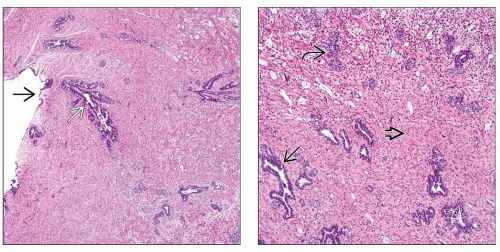Prostate
Staci Bryson, MD
Key Facts
Embryology
Forms in early embryonic life from condensation of mesenchyme along pelvic urethra
Mainly urogenital sinus mesenchyme
Prostate base and central zone form from wolffian duct mesenchyme
Glandular epithelium forms from outgrowths of prostatic urethral endoderm
Initially forms as at least 5 solid prostatic cords
Epithelial buds begin to branch at 10 weeks
Cords develop a lumen and glandular acini by 11 weeks
Glands begin secretory activity by 13-15 weeks
Initial formation of prostatic cords is induced by mesenchyme
Dependent on conversion of testosterone to dihydrotestosterone
Neural crest-derived neuroendocrine cells necessary to induce branching
Achieves adult contour and location by 9 weeks
Macroscopic Anatomy
Located within true pelvis between bladder neck and urogenital diaphragm
Funnel shaped with base at bladder neck and apex at urogenital diaphragm
Outer zones are termed peripheral and central
Central is toward base
Inner zone (periurethral) is termed transitional
Prostatic urethra begins on superior surface and descends through prostate almost vertically
Term prostate measures ˜ 1 cm
Microscopic Anatomy
Combination of glandular and nonglandular tissue
Glandular tissue is composed of 3 main epithelial cell types: Basal cells, luminal cells, and neuroendocrine cells
Basal cells
Proliferative compartment of glandular prostate
Low cuboidal and columnar cells
May have prominent nuclear grooves and prominent nucleoli
Apical/luminal cells
Columnar cells with overall basally oriented round nuclei
Luminal cells normally have some variation in size and shape (anisopoikilocytosis)
Abundant cytoplasm with numerous small secretory vacuoles
Secretory vacuoles are most dense in peripheral and transitional zones and give pale to clear appearance to cytoplasm
Cytoplasm with fewer secretory granules in central zone gives a slightly darker appearance to cytoplasm
Neuroendocrine cells: Scattered cells in basal cell layer, not readily apparent by light microscopy, rich in serotonin, neuron-specific enolase, and peptide hormones
4th epithelial cell type termed “transitional cells” have an immunophenotype with overlap between that of basal and luminal cells
Nonglandular tissue includes anterior fibromuscular stroma and prostatic capsule
Anterior fibromuscular stroma consists of coarse interwoven muscle fibers, best developed at apex of prostate
Prostatic capsule consists of inner smooth muscle layer and outer collagenous membrane; relative thickness and relationship between components varies within prostate
Metaplasia
Prostatic glands and ducts can undergo squamous metaplasia during prenatal life in response to maternal estrogen
 (Left) The prostate gland surrounds the prostatic urethra
 as seen here at 26 weeks gestation. The ducts as seen here at 26 weeks gestation. The ducts  of the prostate gland form as branches of the urothelial endoderm. Urothelial cells can extend about 2 mm into the prostatic ducts. (Right) The ducts of the prostate gland form as branches of the urothelial endoderm. Urothelial cells can extend about 2 mm into the prostatic ducts. (Right) The ducts  and acini and acini  are embedded in a fibromuscular stroma are embedded in a fibromuscular stroma  . .Stay updated, free articles. Join our Telegram channel
Full access? Get Clinical Tree
 Get Clinical Tree app for offline access
Get Clinical Tree app for offline access

|